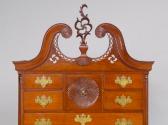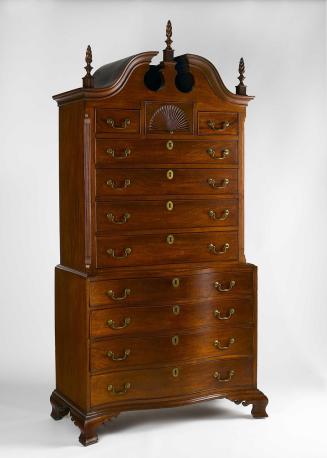Chest-on-chest
Furniture MakerPossibly made by the shop of
Silas Rice
(American)
Date1790-1810
MediumCherry primary wood, tulip poplar and white pine secondary wood, brass hardware
DimensionsPrimary Dimensions (height x width x depth): 88 1/2 x 41 1/2 x 20 1/2in. (224.8 x 105.4 x 52.1cm)
ClassificationsFurniture
Credit LineBequest of Thomas Barbour
Object number2006.9.0
DescriptionCherry Chest-on-chest with a removeable swan's neck pediment in the Federal, or neoclassical, style. The steep swan's neck pediment is open at the center; each upper end of the pediment molding terminates in a carved sunburst rosette. A cartouche (replaced), located at the top of the pediment between the rosettes, is in the shape of a pierced four-lobed pinwheel with asymmetrical C-scrolls above and below; it sits on a bulbous, or waisted, plinth over a semi-circular applied inverted shell. Below the rosettes and molding the pediment has fretwork, or two pierced panels of wood, decorated with ovals; each side of the pediment has a single pierced, four-lobed pinwheel. The upper case drawer arrangement consists of a square drawer carved with a large sunburst and flanked by two drawers stacked two over two; below this are three full-width graduated drawers. The lower case drawer arrangement consists of two full-width graduated drawers over two full-width false drawer fronts separated by a drawer divider; these form the front of a single deep drawer. The front corners of each case have fluted quarter columns; all the flutes have a flat terminal. The top case fits inside the mid-molding of the lower case. The lower case has base molding and ogee bracket feet that project beyond the front and sides of the lower case. Hardware includes a small brass knob on the top center drawer of the upper case. Each flanking drawer has a brass escutcheon with a bail pull. Each full-width drawer has a brass lock escutcheon in the center flanked by an escutcheon with a bail pull.
Condition: The top left side of the pediment is cracked; the entire pediment is reinforced with screws through the back. The knee bracket returns have been reinforced with screws. Four drawer guides in the upper case are replaced. The bottom edges of the drawer sides are repaired or replaced. The bottom of the top full-width drawer is heavily stained and cracked. The right side and some back boards in the lower case are split. There are a significant number of insect holes in the backboards of the lower case; there are a small number of insect holes on the lower backboards of the upper case. The cartouche is replaced. The hardware is original. The chest-on-chest is refinished.
Design and Construction Details:
Case Construction. The removeable pediment is constructed of cornice molding, fretwork and a plinth that are applied to a rectangular frame; the frame is constructed of rails with nailed lap joints at each corner. The cornice molding fits over the upper case and extends below the pediment frame. The backboards of each case are horizontally oriented, chamfered, and slide into grooves in the back interior sides of each case; this joint is reinforced with nails through the back edge of each side of the upper and lower case. The top of the upper case is joined to the case sides with dovetails. The base of the lower case is constructed of a three-sided frame with mitre joints at each corner that extends at the front and sides to form the base molding. The ogee bracket feet are constructed of molded ogee facing that is applied to the frame; the back facing of the back feet are replaced with plain boards. The feet are supported by vertically-oriented glue blocks at the interior corners. The ogee bracket feet do not splay.
Drawer Construction. Each drawer front is flat and has thumbnail, or ovolo, molding at all four edges. Drawer dividers are dovetailed into the case sides. The vertical partitions slide into a groove in the top of the upper case and into the top of the top full-width drawer divider. The central drawer runners for the top drawers are tenoned through the backboard. The side drawer runners slide into grooves in the sides of the case. Drawer guides are glued down on top of the drawer runners (four are replaced). Each drawer front is solid with a flat interior surface. The drawer sides are rounded on top. The drawer bottoms are chamfered and fit into grooves in the front and sides of each drawer and are nailed at the back.
Condition: The top left side of the pediment is cracked; the entire pediment is reinforced with screws through the back. The knee bracket returns have been reinforced with screws. Four drawer guides in the upper case are replaced. The bottom edges of the drawer sides are repaired or replaced. The bottom of the top full-width drawer is heavily stained and cracked. The right side and some back boards in the lower case are split. There are a significant number of insect holes in the backboards of the lower case; there are a small number of insect holes on the lower backboards of the upper case. The cartouche is replaced. The hardware is original. The chest-on-chest is refinished.
Design and Construction Details:
Case Construction. The removeable pediment is constructed of cornice molding, fretwork and a plinth that are applied to a rectangular frame; the frame is constructed of rails with nailed lap joints at each corner. The cornice molding fits over the upper case and extends below the pediment frame. The backboards of each case are horizontally oriented, chamfered, and slide into grooves in the back interior sides of each case; this joint is reinforced with nails through the back edge of each side of the upper and lower case. The top of the upper case is joined to the case sides with dovetails. The base of the lower case is constructed of a three-sided frame with mitre joints at each corner that extends at the front and sides to form the base molding. The ogee bracket feet are constructed of molded ogee facing that is applied to the frame; the back facing of the back feet are replaced with plain boards. The feet are supported by vertically-oriented glue blocks at the interior corners. The ogee bracket feet do not splay.
Drawer Construction. Each drawer front is flat and has thumbnail, or ovolo, molding at all four edges. Drawer dividers are dovetailed into the case sides. The vertical partitions slide into a groove in the top of the upper case and into the top of the top full-width drawer divider. The central drawer runners for the top drawers are tenoned through the backboard. The side drawer runners slide into grooves in the sides of the case. Drawer guides are glued down on top of the drawer runners (four are replaced). Each drawer front is solid with a flat interior surface. The drawer sides are rounded on top. The drawer bottoms are chamfered and fit into grooves in the front and sides of each drawer and are nailed at the back.
Status
On view

















